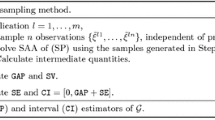Abstract
Statistically motivated algorithms for the solution of stochastic programming problems typically suffer from their inability to recognize optimality of a given solution algorithmically. Thus, the quality of solutions provided by such methods is difficult to ascertain. In this paper, we develop methods for verification of optimality conditions within the framework of Stochastic Decomposition (SD) algorithms for two stage linear programs with recourse. Consistent with the stochastic nature of an SD algorithm, we provide termination criteria that are based on statistical verification of traditional (deterministic) optimality conditions. We propose the use of “bootstrap methods” to confirm the satisfaction of generalized Kuhn-Tucker conditions and conditions based on Lagrange duality. These methods are illustrated in the context of a power generation planning model, and the results are encouraging.
Similar content being viewed by others
References
J.R. Birge and F.V. Louveaux, A multicut algorithm for two stage linear programs, Europ. J. Oper. Res. 34 (1988) 384–392.
J.R. Birge and R.J.-B. Wets, Designing approximation schemes for stochastic optimization problems, in particular, for stochastic programs with recourse, Math. Progr. Study 27 (1986) 54–102.
F.H. Clarke,Optimization and Nonsmooth Analysis (Wiley, 1983).
G.B. Dantzig, P.W. Glynn, M. Avriel, J.C. Stone, R. Entriken and M. Nakayama, Decomposition techniques for multiarea generation and transmission planning under uncertainty, Stanford University, Stanford CA (1989).
B. Efron, Bootstrap methods: another look at the jackknife, Ann. Statist. 7 (1979) 1–26.
B. Efron,The Jackknife, the Bootstrap and Other Resampling Plans, CBMS-NSF Regional Conference Series in Applied Mathematics (SIAM, Philadelphia, PA, 1982).
Y. Ermoliev, Stochastic quasigradient methods and their application to system optimization, Stochastic 9 (1983) 1–36.
K. Frauendorfer, Solving SLP recourse problems with arbitrary multivariate distributions—the dependent case, Math. Oper. Res. 13 (1988) 377–394.
K. Frauendorfer and P. Kall, A solution method for SLP recourse problems with arbitrary multivariate distributions — the independent case, Problems of Control and Information Theory 17 (1988) 177–205.
A. Gaivoronski, Implementation of stochastic quasigradient methods, in:Numerical Techniques for Stochastic Optimization, ed. Y. Ermoliev and R.J.-B. Wets (Springer, Berlin, 1989) pp. 313–351.
J.L. Higle and S. Sen, Stochastic Decomposition: an algorithm for two stage linear programs with recourse, to be published in Math. Oper. Res.
J.L. Higle and S. Sen, On the convergence of algorithms with applications to stochastic and nondifferentiable optimization, to be published in Math. Oper. Res.
P. Kall, Approximation to optimization problems: an elementary review, Math. Oper. Res. 11 (1986) 9–18.
A. King and R.J.-B. Wets, Epi-consistency of convex stochastic programs, Research report RC 14640No. 65642), IBM Research Center, Thomas J. Watson Center, Yorktown Heights, NY (1989).
D.G. Luenberger,Linear and Nonlinear Programming (Addison-Wesley, Reading, MA, 1984).
M.M. Mitwasi, M.S. Sodhi, D.S. Yakowitz, J.L. Higle and S. Sen, Computational experience with stochastic decomposition, CORS/ORSA/TIMS Joint Meeting, Vancouver, B.C., Canada.
G. Pflug, Stepsize rules, stopping times and their implementation in stochastic quasi-gradient algorithms, in:Numerical Techniques for Stochastic Optimization, eds. Y. Ermoliev and R.J.-B. Wets (Springer, Berlin, 1989) pp. 353–372.
Author information
Authors and Affiliations
Additional information
This work was supported in part by Grant No. AFOSR-88-0076 from the Air Force Office of Scientific Research and Grant No. DDM-89-10046 from the National Science Foundation.
Rights and permissions
About this article
Cite this article
Higle, J.L., Sen, S. Statistical verification of optimality conditions for stochastic programs with recourse. Ann Oper Res 30, 215–239 (1991). https://doi.org/10.1007/BF02204818
Issue Date:
DOI: https://doi.org/10.1007/BF02204818



